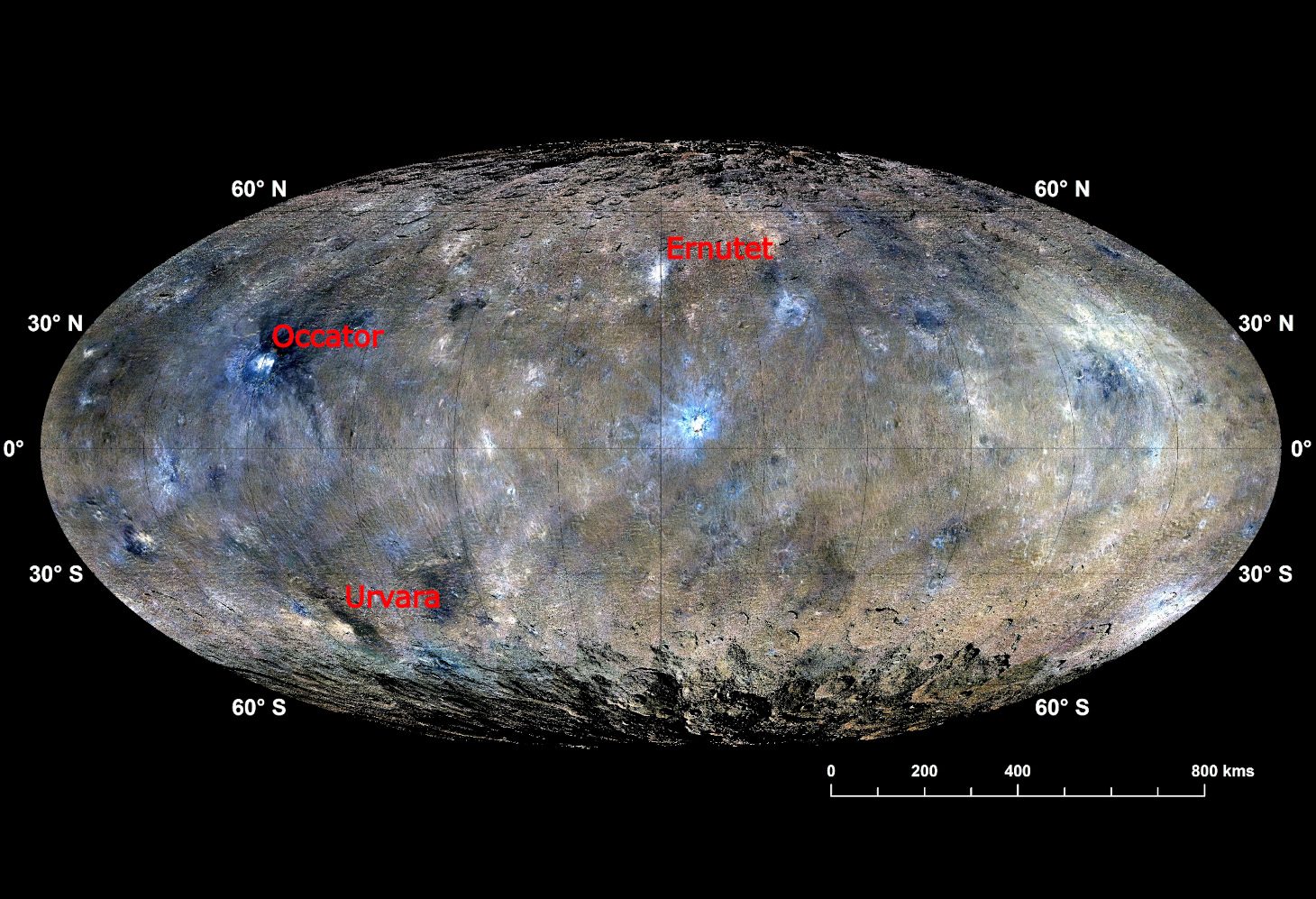The small world in the asteroid belt once had an underground ocean, remnants of which may still be found. This assumption is now supported by test results from Urvara crater in the south of the dwarf planet Ceres: data from NASA’s Dawn mission “extension” shows traces of ice volcanoes there. Long after the formation of the impact basin, the brine rose from the depths and the organic compounds were deposited.
It is the largest of the young: with a diameter of about 950 kilometers, the dwarf planet Ceres is the largest mass in the asteroid belt between Mars and Jupiter. Data from NASA’s Dawn probe impressively showed the astonishing complexity of this celestial body: it orbited Ceres between 2015 and 2018 and provided detailed images. Scientists focused primarily on drilling. The most visible is “Okator” in Ceres’ northern hemisphere. Studies of its structures have already provided exciting clues to the hidden features of the dwarf planet. Because inside, underground brine remains have been discovered, which apparently reached the surface through glacial volcanic processes until very recently. In addition, there were already indications that Ceres had a very complex chemistry: signs of containing exposed carbon – so-called organic compounds – had been discovered in the Ernutet crater.
Detailed view of Urvara . crater
“The large impact structures on Ceres give us access to the deeper layers,” says Andreas Nathues of the Max Planck Institute for Solar System Research in Göttingen. In the current study, he and his colleagues have now targeted another notable scar on the dwarf planet: At 170 kilometers in diameter, “Urvara” is Ceres’ third largest. The results are based on previously unassessed spectroscopic images and data from the Dawn mission. They arose during the “extension”: after the completion of the planned actions, the remaining fuel was still enough for risky maneuvers. The astronomers drove Dawn into powerful elliptical orbits in order to bring the probe as close as possible to the surface of Ceres in some places. This resulted in images of Urvara crater that show structures only a few meters in size.
As reported by the researchers, the images show multiple terraced cliffs surrounding the impact basin. A little further from the center of the crater, a mountain range of about 25 kilometers in length and three kilometers in height is especially noticeable, which is distinguished by rugged cliffs and boulder fields, as well as noticeably smooth areas and other structures. Some spots of bright material similar to those in Okator Crater are of particular interest.
Cryogenic volcanoes and organic compounds
First, the researchers determined the age of the different regions: to do this, they calculated the small impact marks in the crater region: because older surfaces had more time to “accumulate” impacts from smaller pieces of space, they had more craters than younger ones. According to the results, most of the original areas of the Urvara crater are about 250 million years old – at that time they were formed by the impact of an asteroid impact. “However, our assessments have shown that different regions of the crater vary greatly in age,” says co-author Nico Schmedemann of the Institute of Planetary Science at Westfälische Wilhelms-Universität Münster. “The age difference is up to 100 million years. This scientist shows that processes were at work there and were active long after the crater had already formed.”
Thus, the smaller surfaces within the crater include the broad smooth and dark areas. There are also structures that researchers have identified as holes, which may have formed due to underground gas leakage. Other indications of past geological activity emerged from the analysis of the spectral recordings. Bright spots in particular were the focus of attention. The properties of the light reflected from the surfaces allowed to draw conclusions about their mineral composition.
Underground wet salty?
As it turned out, these are salts. What was particularly interesting was that on a slope to the west of the central mountain range, the researchers found a relatively small deposit of salts with previously unknown organic compounds. Co-author Guneshwar Thangjam of the Indian National Institute of Science Education and Research in Bhubaneswar asserts that “these organic compounds, which appear in Urvara crater in the southern hemisphere, are very different from those in the Ernutet crater regions of the northern hemisphere.”
Survey results from Urvara crater shed more light on Ceres’ complex features. “In general, Urvara crater presents us with a very complex picture that we do not yet fully understand, and this leaves room for interpretation. However, there is some evidence of the involvement of brine, which rose from the interior and led to further processes, says Nathos. The current findings support the current findings. Also an interesting theory previously developed based on Dawn data: Ceres may have once had a deep ocean containing organic compounds. The remains may have survived to this day in liquid reservoirs about 40 kilometers deep. Because the high salt content could have saved them From antifreeze, so the assumption.
With more data assessments, the scientists now want to devote themselves to more detailed research into organic compounds. “The question of the origin and composition of Ceres’ organic matter remains open. The answers could have implications for our understanding of Ceres’ entire geological history, potentially leading to links with questions in astrobiology,” concludes Thangam.
Source: Max Planck Institute for Solar System Research, Nature Communications, doi: 10.1038/s41467-022-28570-8

“Alcohol buff. Troublemaker. Introvert. Student. Social media lover. Web ninja. Bacon fan. Reader.”






More Stories
Ecologists Celebrate New Xesap National Park in Laos | Science
Is the wrong diet making you forget?
We can study it with a new telescope.